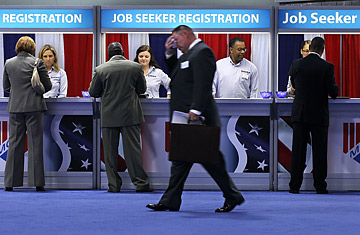
A job seeker passes by the registration booths during a career fair at the Walter E. Washington Convention Center September 27, 2011 in Washington, DC.
(2 of 3)
Yet America misdiagnosed the problems. Rather than focus on the overseas challenge to U.S. competitiveness, Ronald Reagan declared in 1980 that government was not the solution to our problems--it was the problem. The key to re-establishing a sound economy, he claimed, was to slash taxes, reduce government programs like energy research and social insurance and generally adhere to a free-market course.
The Reagan diagnosis neglected the fact that the federal government had been a handmaiden of the country's inclusive growth of the 1950s and '60s. Worse, the Reagan Revolution failed to grapple with the even bigger upheaval of globalization.
It's hard to overstate the long-term consequences of these global changes and our failure to adjust to them. The new globalization has accelerated the hollowing out of U.S. industries such as apparel, autos and textiles and in the process devastated the middle class employed in manufacturing, except in the highest-skill areas. Although American consumers have been the beneficiaries of a flood of low-cost and high-quality Chinese products, America's industrial workers have paid for it in wage cuts and higher unemployment. The median earnings of full-time male workers reached their peak way back in 1973. Female workers have fared somewhat better, in part because they are disproportionately in areas like health care and education, which are more sheltered from global competition. The earnings of the CEOs who oversaw this loss of competitiveness, of course, soared spectacularly, especially as they grabbed stock options designed for their benefit.
This deterioration in Main Street earning prospects was covered up for more than 20 years by debt. First, there was mortgage debt. Washington encouraged housing construction at every turn through Fannie Mae and Freddie Mac, Wall Street deregulation and the Fed's low-interest-rate policies. The housing sector seemed like an employment winner, creating construction jobs that at least partly offset the lost manufacturing jobs. A winner, that is, until the bubble collapsed in 2007.
Eager to keep voters feeling prosperous, Washington also fed the fever of consumer credit. If people could no longer earn their way to affluence, they could try to borrow their way instead. Only in 2008 did households come to understand the precariousness of their balance sheets.
The surge of financial inequality and recklessness has been a bipartisan affair, aided and abetted by every administration and Congress since 1981. And leaders from both parties have yet to accept the magnitude of the shifts in the world economy and the scope of the solutions needed. When Obama took office in 2009, he treated the financial crisis as a major but temporary shock. Obama called for a two-year jolt to spending. The famous stimulus legislation was a haphazard mix of tax cuts and spending increases, with no real attention to the long term. The idea was to build a bridge over the downturn and hope that the economy would bounce back to life by 2010.
